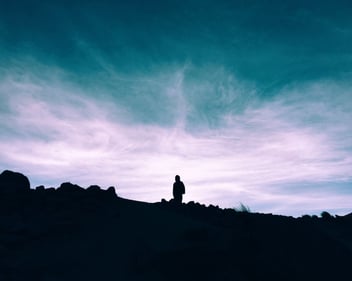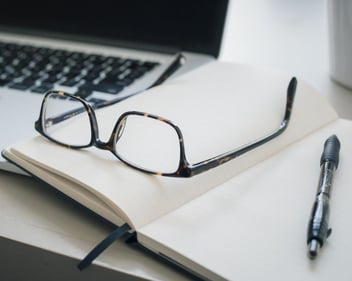by Lisa Hiton

Whether you’re deep into your amateur sleuthing as a mystery writer, or tapping out your town’s top stories as a fledgling journalist, asking good questions and making keen observations are key skills for any writer. For me, amateur sleuthing is where I first began observing the world around me like a writer.
By sixth grade, after our first encounter with Alfred Hitchcock (Vertigo and North by Northwest to be precise), my best friend and I became consumed by the elements of mystery. I remember us taking the train into the city of Chicago, armed with hand-sized steno pads. As we sat in the quiet of the train, we began taking notes. The man across from us wore red sneakers. He kept looking sideways from his newspaper. He flipped the pages of the paper faster than it seemed someone could be reading. These notes were the beginning of a mystery for us.
While in the end, no great narrative came from observing this gentleman ride the train, the exercise was the beginning of a life’s commitment to observation and asking questions. To that end, I became a writer, while my friend became an analyst for the intelligence community. She may have more of a foray into the real mysteries than I do, but I’m happy to use these skills in other pastures.
Alfred Hitchcock was a master observer of the human condition, allowing him to make films that get to the core of our biggest fears.
What is Observation Good for?
Observation and questions are important in all fields of study and all genres of writing. A food writer may observe how a chef cooks, what different dough rolling techniques are like in different cultures, how different spices smell. They might also take those observations to generate questions for their larger story: Why do different cultures roll out dough using different techniques? How do these ingredients tell a story? Is it a family story? Or the story of a larger culture? The relationship between observations and the questions they lead to allows writers, journalists, and storytellers to keep with a subject deeply, and sometimes, for years.
And so, dear writers, as we go ahead into our life’s work, we must practice these observation skills. We must dedicate our time and power to giving readers the details—of characters, real people, landscapes, sporting events, far away places, the world. It is only through taking these notes down and braiding them together that we can share parts of the world and our imaginations with others.
Play a Game: I Spy

Many of us have memories of riding in the car or taking public transport with our family. While on a given drive to grandma’s house or on a train ride to a different state, to occupy the time, we often play games. The simple act of playing “I Spy” while on a road trip is a great way to understand the role of observation for writers.
In a car, on a train, or even on foot, a journey presents us with an evolving landscape. The “I Spy” game is a way to mark how a landscape changes. You can go from an urban area full of buildings, pedestrians, trucks, and noises, to a pastoral full of cows, horses, sky, cornfields, and intermittent barns. On foot, you may go from the cut-grass of a lawn, to a sidewalk, to a park, to the woods. Noting these changes—whether it’s as small as noticing the sound of a cricket or as large as suddenly seeing a city’s skyline in the distance—fuels our understanding of the world in and out of books.
To take this childhood game into the realm of a writer’s practice begins by grabbing a notebook and a pen. Then seeing where the world of observation takes you—what questions do your observations raise, and how can you convey these answers and mysteries to readers in every genre?
The Train Game
You might make your first assignment as an observer the same as mine: riding a train. This prompt could also be done out of any window—a house window, car window, window at the back of your math class (I’m a big believer in daydreaming during math class…).
The first part of the prompting is about strict observation out the window:
- Look out the window. What do you see? Make a list. List everything. List what you find beautiful and interesting. List what is mysterious. List what is boring.
- Annotate your observations. How might you rank your observations? How might you categorize them?
A window is a good place to begin because it keeps things simple. Only what enters the frame is allowed into your observations. As you annotate, note when your mind leaps elsewhere, and where it leaps to. Do you imagine where a bird went? Did you keep thinking about that orange house you passed at the beginning of your observation journey? Why? What else might you want to write about those things?

Covertly Observing Conversations
Once you’ve begun honing in your observation skills, you’ll be observing the world around you everywhere you go. A trip to the grocery store could turn into an entire character study of your local cheesemonger. The next phase of observation is working with people.
We all love people watching. It’s human nature. While it’s not good to gawk or stalk, the casual observations of others, connecting to people we encounter in everyday places, can be fodder for practicing your observing and listening skills, which in turn, will strengthen your writing. So grab your notebook and pencil and head to your local grocery store, library, or coffee shop and be ready to add character study, dialogue, and place description into your observing practice.
- First, observe people conversing from a distance where you cannot hear the conversation. What do you notice? What gestures do they make? What is each person’s posture? What clues do these give you about what they may be talking about? Are they arguing? Gossiping? How would you describe their connection? Why?
- Next, find a place where you can listen in on a public conversation/dialogue.. For example, get in line at your coffee shop and listen to how the hostess taking orders may respond to different people in line. Make notes about dialogue. But focus more of your attention on the details. The tone, the postures, the gestures.
- Annotate your observations. What encounters are you most drawn to? Why? What themes can be made of your details? What follow-up questions would you want to ask if you had the opportunity to do so?
Sometimes, these observations can lead directly to a story by following the questions that are raised. Maybe you noticed a little girl by herself stealing an olive from the olive bar at your grocery store. How did she get there? Why is she alone? Do her parents know she’s tasting an olive? Is this her first olive? Does she love olives? Or did she grab the wrong thing? Inventing these answers can lead to a great character study, and possibly even a scene from a short story or even a novel.
In other cases, the observations and the questions they raise may lead to something else altogether. Let’s say you’re observing a librarian and her interactions with readers like yourself. Maybe you overhear her recommend your favorite book to someone. That connection might lead you to go talk to her. Perhaps, eventually, you ask if she’d be willing to do an interview so you can write a portrait piece on her and her work or a feature on the library as a whole. By simply seeing the world around you, you’ll become more connected to it—in a literal sense as well as an imaginative one.
About Lisa
Lisa Hiton is an editorial associate at Write the World. She writes two series on our blog: The Write Place where she comments on life as a writer, and Reading like a Writer where she recommends books about writing in different genres. She’s also the interviews editor of Cosmonauts Avenue and the poetry editor of the Adroit Journal.





